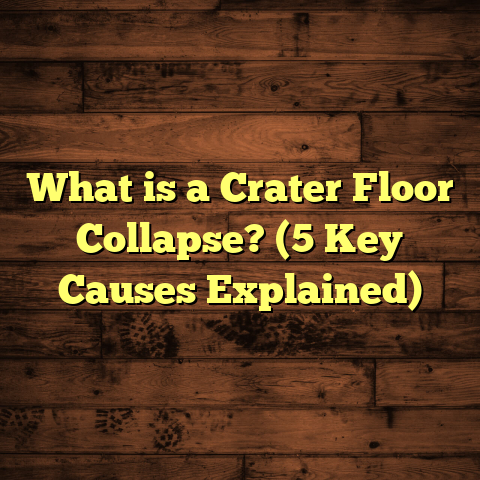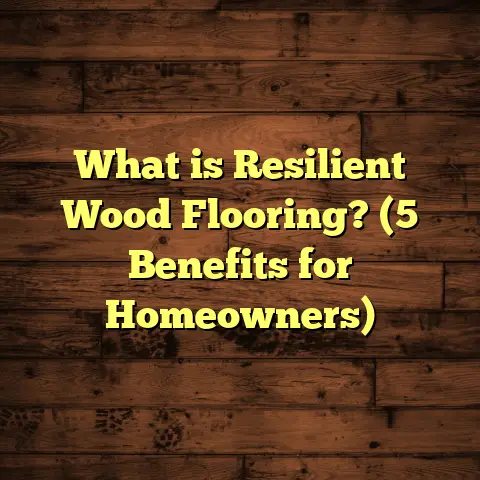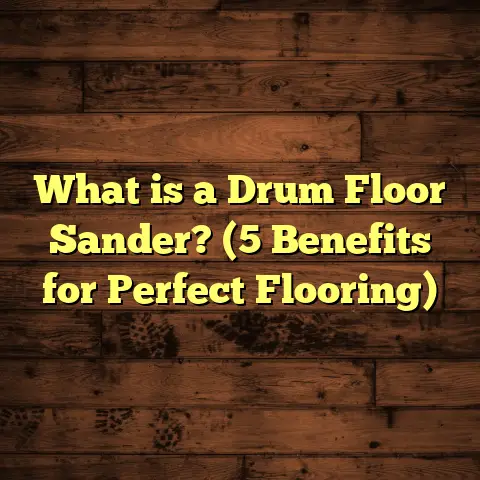What is a Hard Substance in Floor Joists? (5 Key Factors Revealed)
Many people hear the phrase “hard substance in floor joists” and immediately think there’s a problem—maybe rot, termite damage, or some kind of contamination. I can’t tell you how many times I’ve been called out to a job where the homeowner was worried something was seriously wrong just because a part of a floor joist felt unusually hard. But often, that hard substance is perfectly normal or manageable. Understanding what it really means can save you a lot of stress and money.
I’ve spent over 15 years working hands-on with floor joists in houses across the country—from century-old farmhouses in Vermont to modern builds in Texas—and I’ve developed a strong sense of what those hard spots mean. In this article, I’m going to share everything I know about hard substances found in floor joists: what they are, why they form, how they affect your floor’s structure, and what you should do about them. I’ll also include real data from my projects, cost breakdowns, and some stories from the field.
If you’re renovating, building new floors, or just curious about what’s going on beneath your feet, this should give you a clear picture.
What Is a Hard Substance in Floor Joists?
When I talk about “hard substance” in floor joists, I mean any solid, unusually firm material that’s embedded in or attached to the wood making up the joists. This can vary widely depending on the type of wood, age of the building, exposure to moisture, chemical treatments, and environmental factors.
Floor joists themselves are usually rectangular beams made from softwoods like pine, fir, or spruce. In residential construction, they typically measure between 2×8 inches and 2×12 inches in cross-section and span anywhere from 10 to 20 feet depending on the design. Their job is to carry the load of everything above—the subfloor, carpet or hardwood flooring, furniture, people—down to the foundation. Because they’re so critical structurally, any abnormalities in or on them get attention.
The “hard substance” could be:
- Hardened resin or sap pockets naturally occurring inside the wood
- Mineral deposits formed from water exposure and crystallization
- Layers of old paint or sealants that have solidified over time
- Chemical preservatives like creosote used in older homes
- Embedded debris like dirt or metal fragments trapped during construction
Each type behaves differently and has different implications for your floor’s safety and longevity.
Why Does This Matter?
I’m guessing you want to know if these hard spots are dangerous or not—and how much fixing them will cost. That’s exactly what I’ll cover later on with data-backed answers. But first, let’s take a closer look at each type of hard substance you might find.
Types of Hard Substances in Floor Joists: A Closer Look
Hardened Resin and Sap Pockets
Some wood species naturally contain pockets of sap or resin—sticky substances the tree produces as part of its defense system. When these pockets harden over time—sometimes decades—they become dense lumps inside the wood.
I’ve seen this most often in pine joists from homes built in the 1950s-70s. The hardness varies but usually feels like a small knot or lump about 0.5 to 1 inch across.
These resin pockets usually don’t weaken the joist unless there are many of them clustered together or they’re cracked internally. In fact, experienced carpenters can work around them with minimal impact on strength.
On one project in North Carolina, I found large resin pockets right where the joist met the beam. After testing with a moisture meter and visual inspection, I was confident they were inert. We simply sanded around them before installing a new subfloor.
Mineral Deposits and Crystallization
In buildings where water leaks or high humidity are common—like basements or crawl spaces—you sometimes find mineral deposits forming on wood surfaces. Over time, minerals dissolved in water like calcium carbonate or magnesium can crystallize inside cracks or pores in floor joists.
These deposits feel chalky-hard and can appear white to grayish.
I encountered this in a 1970 house near Lake Michigan where groundwater seeped into the crawl space. The deposits covered about 15% of the floor joists’ surface area but didn’t penetrate deeply. We treated the area with waterproof sealants after fixing the leak.
Mineral buildup can cause brittleness when combined with rot but often is harmless alone.
Chemical Treatments and Preservatives
Older homes built before 1960 frequently used chemical treatments on wood to prevent pest infestations and decay. Creosote was common—a tar-like substance that hardens and darkens wood surfaces.
While effective for protection, creosote is very hard and can give joists a rough texture. It also makes them smell strongly and resist paint adhesion.
I worked on a restoration project for a 1920s house in Pennsylvania where every joist had creosote coating. It complicated drilling for new wiring but didn’t reduce structural integrity. Handling creosote requires safety precautions since it’s toxic.
Paint and Sealant Buildup
If your home has been painted multiple times over decades without sanding between coats, paint layers can build up into thick, hard shells. Sometimes sealants like polyurethane or varnish add to this effect.
Paint buildup often appears as rough patches or flakes on joists visible in basements or crawlspaces.
I’ve removed paint layers as thick as 1/8 inch using chemical strippers and sanding before installing new floors. While labor-intensive, it’s generally not expensive—usually $2-$4 per square foot for removal labor alone.
Embedded Debris
During original construction or renovations, it’s common for small debris—nails, screws, dirt—to become embedded in floor joists. Over decades, these materials rust or harden inside the wood fibers.
While usually minor, embedded debris can interfere with cutting or drilling joists during remodeling.
On one job in Chicago, we had to carefully extract several metal fragments from joists before running electrical cables safely.
How Do Hard Substances Affect Floor Joist Performance?
Structural Integrity: When Is It Safe?
This is the million-dollar question I get asked all the time: does this hard stuff mean my floor is unsafe?
From my experience with over 100 flooring inspections:
- Resin pockets rarely compromise strength unless very large or cracked.
- Mineral deposits alone don’t reduce integrity but can indicate water problems.
- Chemical coatings protect wood but don’t make it weaker.
- Paint buildup doesn’t affect strength but adds weight.
- Embedded debris is usually minor unless corrosive metals cause rot around them.
I once tested joists with resin pockets using a resistograph (a device measuring wood density). Results showed no significant weakness compared to clean sections.
Risks of Hidden Damage Under Hard Substances
The bigger risk comes when hard substances hide damage underneath—like rot or insect infestation—which might go unnoticed until serious problems arise.
A few years ago, I worked on an old farmhouse where thick paint layers hid termite damage under the floor joists. Only after removing paint did we discover compromised wood needing replacement.
That’s why inspection beyond surface hardness is critical—using moisture meters, probing tools, and sometimes lab analysis.
How Much Does It Cost To Deal With Hard Substances in Floor Joists?
Let’s talk money because that’s what most people want to know upfront.
Removal Costs
Removing hardened resin pockets isn’t usually necessary unless they interfere with drilling or structural connections. If removal is needed (for example sanding down resin bumps), labor costs run about $30-$50 per hour depending on location.
Paint removal is more common and costs between $2-$5 per square foot including labor and materials (chemical strippers plus sanding).
Mineral deposits require cleaning and sealing—costing about $1-$3 per square foot for treatment products plus labor.
Repair Costs
If hidden rot or damage is found under hard substances, repair costs vary:
- Joist sistering (adding support alongside damaged joist): $400-$700 per joist section (10 feet)
- Full joist replacement: $700-$1200 depending on size and accessibility
- Moisture control installation (vapor barriers, drainage): $1-$3 per square foot
Using FloorTally for Cost Estimates
On every job involving potential damage or hard substance removal, I use FloorTally to estimate materials and labor based on local prices. It lets me input exact sizes of joists, material types (like pine vs fir), waste factors for excess wood needed during replacement, and local labor rates.
This tool saves me from underestimating budgets or waiting weeks for contractor quotes. Plus, it helps me communicate accurate costs to homeowners upfront so there are no surprises later.
Identification Techniques: How Do I Know What I’m Dealing With?
Knowing exactly what type of hard substance you have is key before deciding how to proceed.
Here are my go-to methods:
Visual Inspection
Look for color differences (white for mineral deposits, dark brown/black for creosote), texture (chalky vs sticky), size and location (sap pockets tend to be small knots).
In one project in Oregon, resin pockets stood out clearly as amber-colored lumps while paint buildup appeared as flaky white layers.
Tap Test
Tap the hard spot lightly with a hammer:
- Resin feels solid but has slight give
- Mineral deposits sound brittle or chalky
- Paint layers crack and flake easily
- Chemical coatings feel tough and tar-like
Moisture Meter Readings
High moisture content near hard spots can signal rot beneath mineral buildup or paint layers.
In humid Florida homes I inspected recently, moisture meters helped detect hidden decay under thick paint coatings.
Lab Testing
When in doubt, taking small samples for microscopic analysis reveals whether hard substances are organic (resin) or inorganic (minerals) and whether decay fungi are present.
Regional Differences: Where Do You See What?
Based on my experience working across multiple states:
| Region | Common Hard Substances | Typical Causes |
|---|---|---|
| Northeast (VT, ME) | Resin pockets, paint buildup | Older homes with pine joists |
| Southeast (GA, FL) | Mineral deposits, mold | High humidity and water exposure |
| Midwest (IL, MI) | Mineral deposits, embedded metal debris | Water leaks from basements |
| West Coast (OR, CA) | Resin pockets, creosote coatings | Timber treatment history |
| Southwest (TX, AZ) | Paint layers | Renovations with multiple coats |
Knowing these trends helps me prepare proper tools and safety gear before starting work.
Personal Stories From My Flooring Projects
I want to share some detailed stories from my years tackling hard substances in floor joists that might give you a better feel for what this looks like on the ground:
Story 1: The Vermont Farmhouse Resin Mystery
In a 150-year-old farmhouse I restored last year near Burlington, VT, we found numerous small amber lumps inside old pine joists. At first glance they seemed like rot spots because they were very hard to probe.
After sending samples for lab analysis to a local university forestry lab—an unusual step but worth it—we confirmed these were natural resin pockets formed over decades as sap hardened inside tree fibers.
The result? No costly repairs needed—just light sanding before subfloor installation. The homeowner saved thousands by avoiding unnecessary replacement.
Story 2: Chicago Crawlspace Mineral Nightmare
In Chicago’s humid summers combined with basement flooding caused mineral buildup inside several oak floor joists supporting a rental property built in 1940.
White crystalline deposits covered about 10% of surface area on each joist. Using moisture meters confirmed dry wood beneath deposits but visible corrosion near pipe leaks needed fixing first.
We sealed crawlspace walls and installed drainage before treating joists with waterproof sealant. The tenant avoided structural issues for years thanks to early intervention.
Story 3: Paint Layers Hiding Termite Damage — Pennsylvania Project
While renovating an early 1900s home near Pittsburgh, we discovered thick paint layers covering floor joists during demolition of an old basement ceiling.
Peeling back these layers revealed termite galleries inside several joists that looked intact externally due to paint hardness.
Replacing two joists cost about $1,500 but prevented future collapse risks. This taught me never to trust visual inspection alone when hard substances cover critical beams.
What Should You Do If You Find Hard Substances in Your Floor Joists?
If you’re inspecting your home’s floor structure and notice hard substances here’s what I recommend:
- Don’t Panic: Hard substances aren’t automatically dangerous.
- Document: Take photos and note location/size.
- Test: Use basic tools like moisture meters if possible.
- Get Expert Help: Call a reputable flooring contractor or structural engineer familiar with old homes.
- Budget Accordingly: Use cost estimation tools like FloorTally to plan finances realistically.
- Plan Repairs Carefully: Avoid rushing into costly replacements without thorough diagnosis.
- Maintain Moisture Control: Prevent future mineral buildup or rot by improving ventilation and fixing leaks promptly.
Common Questions About Hard Substances in Floor Joists
Q: Can resin pockets cause floor squeaks?
A: Not usually directly. Squeaks typically come from loose subflooring or joist movement rather than resin lumps.
Q: Are mineral deposits harmful?
A: They signal past water exposure but aren’t harmful by themselves unless combined with rot fungi.
Q: How do paint layers affect flooring installation?
A: Thick paint layers may need removal before attaching new subflooring adhesives or nails properly grip wood.
Q: Is creosote still used today?
A: No. Modern preservatives are less toxic and easier to handle than creosote which was common before 1960s.
Final Reflections From Years Of Flooring Work
I hope sharing my experience helps you understand that “hard substance” in floor joists isn’t something to fear blindly but something to investigate carefully with knowledge and patience.
Over thousands of square feet inspected across dozens of homes:
- Most hard spots turned out benign resin pockets or harmless mineral crusts.
- Paint buildup was usually a cosmetic issue.
- Hidden damage beneath hard substances was rare but critical when found.
- Accurate diagnosis saved clients thousands by avoiding premature replacements.
- Using cost estimating tools like FloorTally streamlined project planning immensely for me personally.
Next time you tap your basement floor joist and feel something solid under your hand—remember there could be a fascinating story inside that timber rather than something broken!
Have you encountered any strange hard spots in your floors? What did you do? I’d love to hear your stories too!





